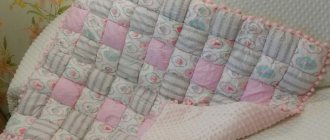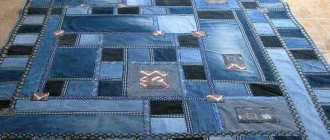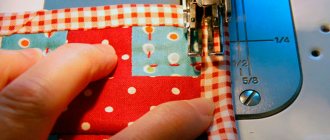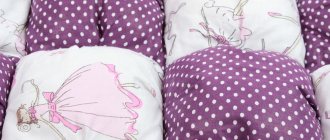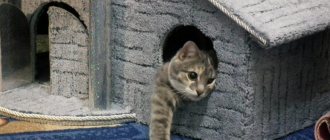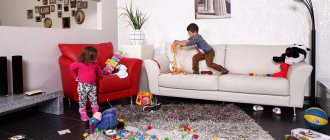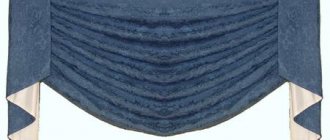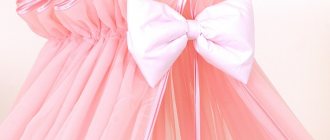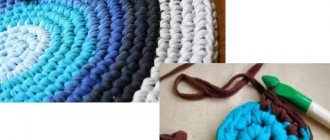A handmade patchwork quilt will be an excellent decoration for a child's room or an original gift
. Nowadays, there are a huge number of techniques for needlework. Recently, the patchwork technique has been increasingly used. Products made using the patchwork method look very unusual, but at the same time elegant. A patchwork blanket is perfect for decorating a boy's or girl's nursery. You can make such a product yourself. All you need is a specific fabric pattern and a little patience.
Making a baby patchwork blanket with your own hands
Before starting work, you must decide on the choice of fabric. The choice of material will depend on the style of the room. It is desirable that the color of the pattern and furniture be the same.
Experts advise giving preference to cotton. This material does not shrink after washing and retains its color for a long time.
To make your own quilt, you will need a ruler, scissors, a sewing machine and a cutter. It is worth noting that you need to take fabrics of different colors. White and yellow materials go well together.
When making a baby patchwork blanket, follow the following algorithm:
- First, cut the white and yellow fabric into squares. The side of the workpiece should be 20-25 cm. Do not forget to trim the edges of the fabric and ensure the symmetry of the parts.
- After this, take a square of white and yellow fabric and place them right side together. Pin the workpiece together.
- Sew the resulting product using a sewing machine. If you still decide to give preference to cotton, use thick needles.
- Then take the workpiece and cut it diagonally.
- As a result, you should have 4 triangles. Iron each piece with an iron. This will help avoid shrinkage in the future.
- Next, you need to loosen the seam and press down the colored side of the seam allowance. Cut off the “ears” that appear using scissors.
- Fold 4 squares and sew them. It is very important to monitor the position of the corners. They need to be perfectly even.
- Once you have made one quilt block, make the rest in the same way.
- Sew all the blocks using a sewing machine.
- Sew insulation with padding made of padding polyester to the wrong side of the blanket. This can be done using a sewing machine or by hand.
- Sew the edges of the resulting blanket. This can be done using a sewing machine. If you don't have one, do it manually.
What tools are needed?
The creative process itself depends on the successful organization of the workplace. Every detail and every tool should be literally at hand, but not create chaos. It is necessary to prepare tools and materials in advance.
- To work you will need sharp scissors and several types of cutting knives.
- Needles are inserted into a sewing machine depending on the type of fabric.
- When selecting threads, you need to focus on the selected material.
- An iron with a steam function must work flawlessly; the patchwork process cannot be done without it.
- You will need pins to secure the fabric.
- You need pre-prepared templates and chalk to work with them.
- Materials (or trimmings) should be selected that are compatible in texture and color.
DIY patchwork quilt for a newborn: step-by-step instructions
You can sew a patchwork quilt for a newborn at home. To sew in a patchwork style, you will need thread No. 45, a square template made of cardboard or plastic, pins, needles, chalk, measuring tape, scissors.
Pay special attention to the choice of fabric. If you are sewing a blanket for newborn babies, use cotton materials. Chintz, linen or calico will do.
In addition, before you start sewing, decide on the material for the insulation. Experts recommend giving preference to batting or padding polyester. These materials cannot harm the health of the child.
A blanket for children should be sewn in the following order:
- First, cut the fabric into individual pieces using a template. It is advisable to number all pieces of fabric.
- Sew all the square pieces into strips and then connect them together. Iron the flaps before sewing them together.
- Pin two pieces of fabric together and stitch them together.
- Place the lining face down on the surface. The dimensions of this blank should be at least 5 cm larger than the shreds.
- Place a layer of batting or padding polyester on the lining. Place the facing material (shreds) on top.
- Pin the blanket together.
- Stitch the blanket using a special darning foot.
- The final stage of making a blanket for children is edging. To carry out this operation you will need 4 strips. The length and width of the strips should be a couple of centimeters larger than the dimensions of the blanket.
- Sew the strips to the edges of the blanket.
- Finally, hand stitch using strong threads.
Blankets and bedspreads using the patchwork technique add coziness to the home. Read more about patchwork and its advantages in the material:
Necessary materials
Choose fabric according to the following criteria:
- wear-resistant and durable, able to withstand repeated washing;
- natural and with antistatic effect (chintz, calico, linen, silk);
- not cause allergies in the baby;
- without toxic dyes;
- all layers must allow air to pass through well.
For the bottom of the blanket, choose a cotton fabric. It is absolutely natural, breathable, but not wear-resistant. Silk and twill are soft to the touch, but require very delicate care. The most acceptable options are cambric, satin, fleece, flannel, calico, bamboo fabric, which meets all the specified criteria. The top part of the blanket can be sewn from any fabric, as long as it is soft and natural.
The following fillers are used.
- Downy – lightweight; soft; air circulates through it, but clumps; it has a characteristic smell.
- Sherstepon – soft; absorbs moisture well and remains dry; It is not recommended to machine wash.
- Sintepon - light; does not provoke allergic reactions; washes well; not expensive.
- Hollow fiber – resistant to knocking down; very warm; does not deform during washing; more expensive than padding polyester.
- Bamboo fiber – meets all criteria; crumples.
The most popular types of filler are padding polyester and holofiber.
Calculate the amount of fabric as follows: take two lengths as measured, take into account a seam allowance of 1.5 cm on each side and 10 cm for shrinkage, i.e. total allowance is 13 cm. Calculate the amount of filler depending on the size of the blanket and the number of layers.
For sewing you will also need threads No. 40-60, machine needle No. 90-100, pins.
Baby Quilts: Sewing Techniques
The most common patterns for sewing patchwork quilts are “Honeycomb”, “Arable”, “American Square” and “Checker”. Typically, a baby blanket is sewn using the Honeycomb technique. A product made using this technology looks very attractive and fits harmoniously into the interior of a children's room. This technique involves making one decorative element from 7 hexagons, which have different colors.
The “Arable land” technique is the simplest and is perfect for beginners. To make a blanket using this technique, you will need pieces of fabric that will be cut into separate strips.
The sewing pattern for the “Arable land” type is as follows:
- The blanket area is divided into 3 identical sections, the boundaries of each should be located at right angles to each other.
- Then each section is divided into parallel strips.
- All stripes are numbered.
- Stripes with the same number must be the same color.
The American Square pattern uses a sewing technique in which all the colored stripes are sewn in a spiral around a small square. Typically, this technology is used in the manufacture of contrasting products. “Chess” is also a common technique. It involves sewing strips of fabric from squares of different colors.
Variety of styles
Chaotic patchwork also has its own directions. Not all of them are ideal for creating blankets using this technique. Styles are:
- classical. The most suitable for sewing a blanket, as it easily fits into the selected dimensions and monotonous decor of the room. This style includes patches of equal size, often in two color schemes, which are placed in clear symmetry or in a checkerboard pattern;
- Oriental. More suitable for decorative small blanket. The style is maintained in the use of flaps of different shapes and sizes, adding to them a variety of embroidery with threads, beads, beads, as well as zippers, buttons, chains and any other type of decorative design. However, unlike the next type, the eastern one adheres to a certain system and symmetry in stitching the flaps;
- crazy patchwork is a “crazy” patchwork technique. The style, which is not limited in the shapes and placement of flaps, combines the chaotic clumsiness of the placement of parts and a mixture of color schemes. More suitable for blankets and bedspreads of outdoor garden decor.
Related article: How to make a St. George ribbon for May 9 from paper with video
Quilt patches come in many forms:
- squares - simple stitching of square flaps of the same size;
- stripes - flaps of stripes can be sewn either alternating or in a circle, into a spiral, decreasing their length as you work, using a template in the form of a lined square;
- triangles - in order to achieve a smooth square canvas at the end, such flaps are cut in the form of isosceles triangles;
- honeycombs - symmetrical hexagons, which are combined with triangular flaps along the edge;
- lapachikha is a type of patchwork made from patches of different shapes, assembled into a specific pattern according to a pre-prepared template.
Caring for a Quilt
In order to maintain the good appearance of a patchwork product, you need to follow some rules. First of all, a patchwork blanket needs to be washed properly. Experts do not recommend washing too often. It is recommended to wash such items by hand in soapy water.
To avoid damage to the fabric, it is important to iron the blanket correctly. If you used padding polyester as a filler, ironing is prohibited. Otherwise, the blanket will lose its texture.
You should also adhere to the following recommendations:
- If you need to hide the blanket for a while, do not fold it. It is better to roll the product.
- If you decide to machine wash your blanket, use the most gentle setting. The optimal water temperature for washing a quilt is 35-40 degrees. Spin must be turned off.
- Using bleach to wash a quilt is strictly prohibited.
Bon Bon
Making a bonbon blanket with your own hands is also possible, although it is a more difficult task. Bonbon is a sewing technique that produces fluffy and soft products that, in addition, look good in the interior.
You will need: three pieces of cotton fabric (can be the same color or different), filler (holofiber is the best option), thread to match the color of the fabric, needle, pins, scissors, ruler.
The working process:
First, a diagram is drawn that represents the layout of the future blanket: a grid of identical squares, each of which corresponds to the future square on the finished product. The shape of the pattern should match the desired shape of the blanket.
According to the diagram, it is tedious to divide the fabric into the same number of squares and arrange them the way they will be sewn. Sew horizontally to create stripes.
- DIY photo frames are popular ways to create from scrap materials. 110 photo frame ideas: wooden frame with buttons, decor with stones and shells, salt dough frame, collages, decoupage
- How to make a picture frame with your own hands? Choice of design and sizes. Instructions for making from scrap materials: cardboard, plinth, newspapers, buttons
- Do-it-yourself drawings on T-shirts - step-by-step instructions, necessary materials, advice from craftswomen. 120 photo ideas on how to make a print on a T-shirt
Then you need to draw out the base fabric into smaller squares, which will be sewn into the middle. You should leave some space for firmware.
In the end, all that remains is to sew all the seams clean (preferably on a machine) and, if desired, edge the edges of the product.
This way you can make a blanket with your own hands, even for a newborn baby, which will be warm and soft. But in this case, you cannot use synthetics or filler, which can serve as an allergen.
Thus, creating a patchwork quilt with your own hands is not technically difficult, but it takes a lot of time and requires concentration and concentration.
- DIY gift baskets are a universal gift for any occasion! 80 photo ideas for decorating baskets: romantic, formal, children's, Italian, Brazilian, for movie fans
- A DIY gift for your loved one: for Birthday, New Year, Valentine's Day, anniversary. 110 photo ideas for original and fun gifts that will surprise your loved one
- Do-it-yourself lambrequins - manufacturing instructions with patterns. Types of lambrequins, choice of variety. Preparation of material and tools. Step-by-step manufacturing guide
Nevertheless, the result is pleasing to the eye and turns out to be useful in everyday life, and can also serve as a good gift for loved ones on any occasion.
For sewing enthusiasts, the task will be interesting, and later, having adapted to the technique, you can create more complex patterns that are unique in their kind.
Patchwork blanket for babies (video)
Making a quilt for a child is quite simple. To do this, you do not need to go to any master class. Just stick to the basic rules of patchwork. It is very important to maintain the symmetry of the squares when working. Otherwise, the blanket will turn out ugly, and the baby is unlikely to like it. When choosing fabrics, pay attention to the fabric. Give preference to natural cotton fabrics, because they are non-toxic and not harmful to the child’s health.
Read more about patchwork techniques in the article:
Recommendations
If you are just taking your first steps in the patchwork style, then you should use some recommendations from experienced craftswomen.
Start with squares. These are the simplest blocks that can be formed from fabric fragments - they are very easy to sew. Leave all the more complex geometric shapes for the future - they will require skill, because sewing the blanks together without distortions is much more difficult.
Take large pieces. The smaller the size of the fabric blanks, the more work you will have to do. Accordingly, this will increase the number of errors, and in addition, you will get tired of such work quite quickly, and it is possible that you will simply quit your job halfway. If you use large scraps of fabric as a basis, the first product will take very little time.
Don't chase originality. For beginners, it is best to copy the work of other masters at first.
First, it is important to “get your teeth into” by creating interior items using ready-made step-by-step master classes. And over time, each needlewoman develops her own individual style.
If you are disgusted by the idea of completely copying the products of another master, simply change the color scheme of the fabric.
Assembling blocks is the main stage of any patchwork sewing, and having mastered this simple technique, you will be able to please yourself and your household with stylish and cozy decorative items that will highlight the unique style of your home.
The fast block technique is presented in the video.
Children's patchwork blanket (photo)
Creation technology
The process of sewing a product from small pieces of fabric is actually a very exciting activity. In addition, it does not require huge financial investments. After all, the necessary materials in the form of various pieces of fabric can be purchased as a set or you can use old things that may be lying in your closet.
As a result, things that have gone out of fashion will be able to continue to exist in a new way and will remind of the wonderful past. But you should not use very old things, so that your diligence will not be in vain.
To create a patchwork quilt, you need to prepare 6 or more different colors of fabric. To realize a unique design with the help of your irrepressible imagination, you should use different colors, fabric structures and patterns on them. Slightly gathered details will add volume to the texture and an impressive appearance.
How to sew a patchwork quilt with your own hands? To do this, just watch master classes from the Internet that will help you learn the patchwork technique yourself.
Colors and prints
The appearance of the blanket directly depends on properly thought out decorative elements. You can use an equal number of squares of different patterns, or you can make sure that some are repeated more often than others.
In order to emphasize variety, striped or asymmetrical patterns are placed differently, rotated 90 and 180 degrees.
If you have a large blanket with small elements in mind, you can combine more complex patterns using triangles and squares. The themes can be different - movies, plants, animals, space - sometimes they can even be combined with each other.
